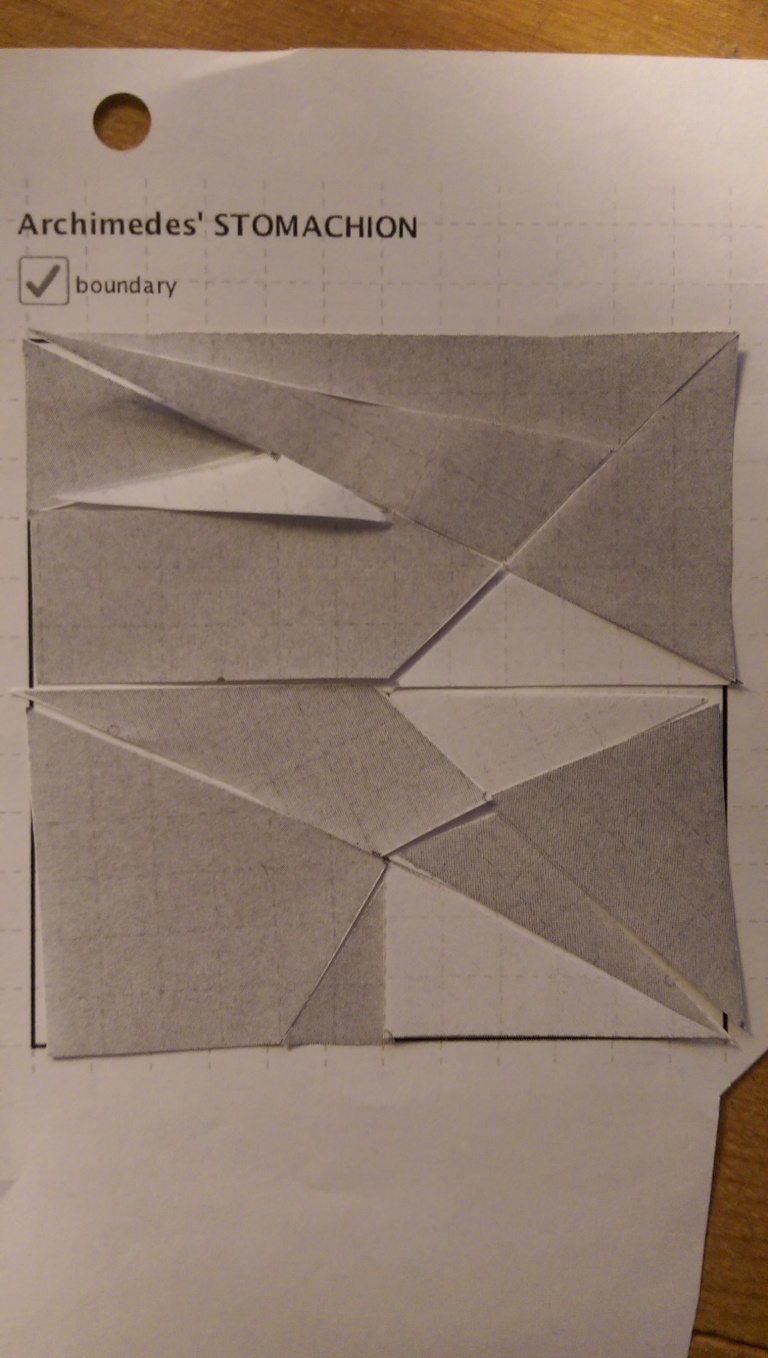 I am a person who really loves puzzles. The math major in me enjoys the logic and the spatial reasoning, the four year old in me enjoys the colors. Puzzles of all kinds are enjoyable; traditional puzzles, 3-D, crossword, Sudoku, to name a few, are all adversaries deemed worthy of my attention. During class on Tuesday, June 17, we were introduced to a different puzzle: Archimedes’s Stomachion.
I am a person who really loves puzzles. The math major in me enjoys the logic and the spatial reasoning, the four year old in me enjoys the colors. Puzzles of all kinds are enjoyable; traditional puzzles, 3-D, crossword, Sudoku, to name a few, are all adversaries deemed worthy of my attention. During class on Tuesday, June 17, we were introduced to a different puzzle: Archimedes’s Stomachion.
Much like a traditional 2-D puzzle the Stomachion presented us with different-shaped pieces that had to fit together as a rectangle (in the Stomachion’s case, a square). What makes the Stomachion the Stomachion is that the shapes are all geometric; triangles and quadrilaterals. With a normal puzzle, you can make an educated guess regarding which pieces with together based on the collora on the pieces and the image you are trying to make. The Stomachion’s shapes have no such image, and can be a random array of colors.
After playing around with the Stomachion in class for about 15 minutes it became clear that it was no normal puzzle. With a normal puzzle a common first move is to find all of the pieces with a flat edge to indicate they belong on the border of the puzzle. Next, those edge pieces are arranged based on their colors so you can make the given image. The shapes in the Stomachion all have straight edges, so there is no way to know for sure which pieces belong on the border.
For the first half hour or so of trying to figure out the Stomachion at home I put pieces together with no real rhyme or reason, trying to mar?tch pieces together that would hopefully span the sides of the square the pieces needed to fit inside. That yielded little progress, and I could not even get two full edges of the border filled. Then the idea dawned on me treat this like a traditional puzzle in a different way: to align pieces together based on edges that had similar lengths.
This yielded much more apparent progress immediately. I started with the large piece in the bottom left corner and continued building out from there, eventually covering the bottom half of the square. That worried me a bit, having a perfect half of the square filled. Conveniently, the light-colored triangle in the middle of the square had a piece that was symmetrical to it, so those seemed to be an obvious pair. The rest of the pieces were easy to fill in based on the method of matching similar-length shape edges.
My conclusion for this activity is that Archimedes had a leg up on his jigsaw-making counterparts, creating this puzzle much in the same way puzzles began to be made in the 1760s. He had this idea to match up the pieces bases on their side lengths, much how jigsaws have pieces that have cutouts that conveniently fit in with each other. He just didn’t have the foresight to have pieces that belonged on the border in such an obvious way.
Nice solution! The only thing I was wishing for were some in progress pictures. Even after you match the edges here, there are a lot of possibilities, right?
I’m also curious about your 1760 reference. What’s that about?
Complete: could use some more visible time. Maybe just describe how long the puzzle took.
clear, coherent, content, consolidated: +
C’s: 4/5
LikeLike
Great job on finishing the Stomachion! I tried to do it online, but I think I would have better success doing the cut out version. It is a tricky puzzle, so thanks for sharing your strategy!
LikeLike